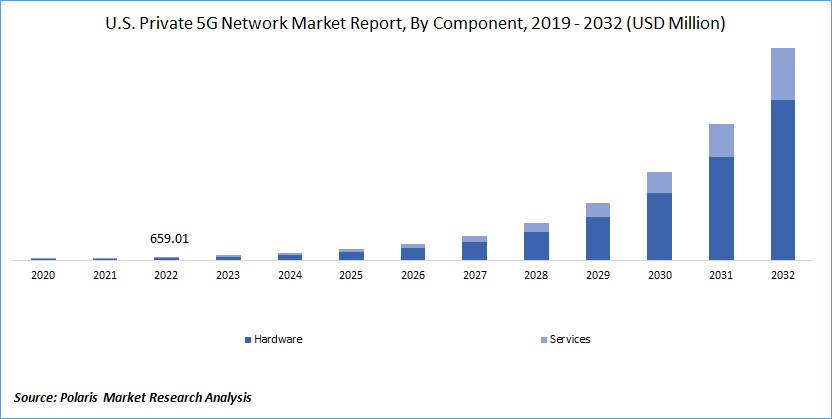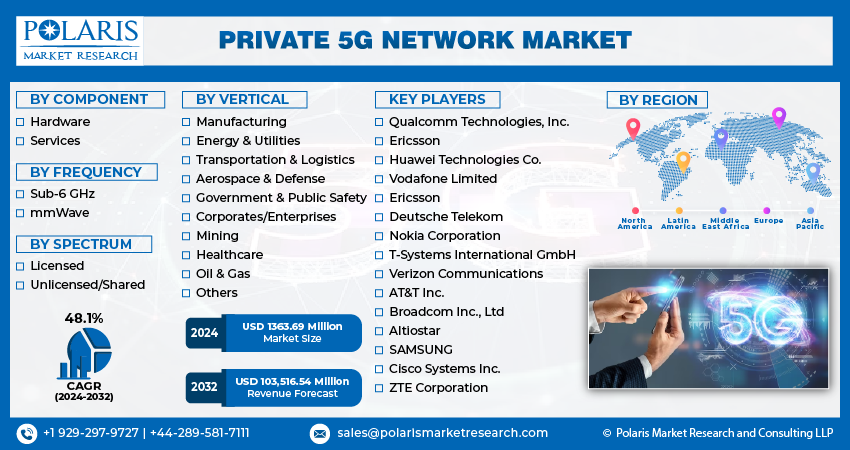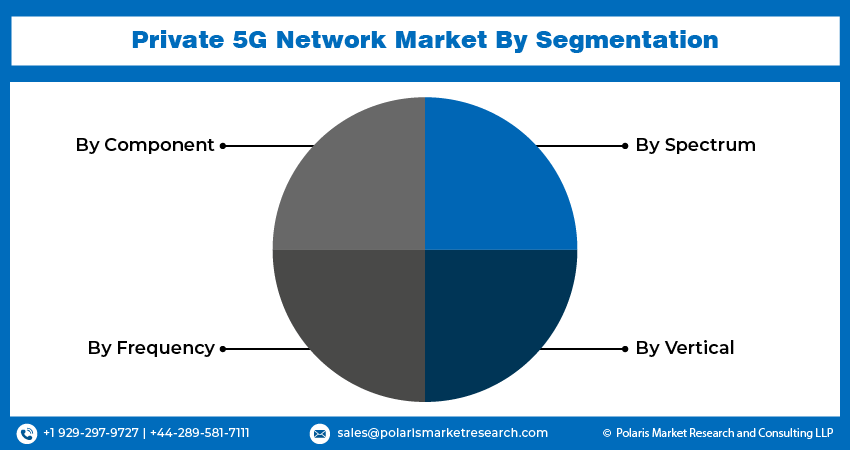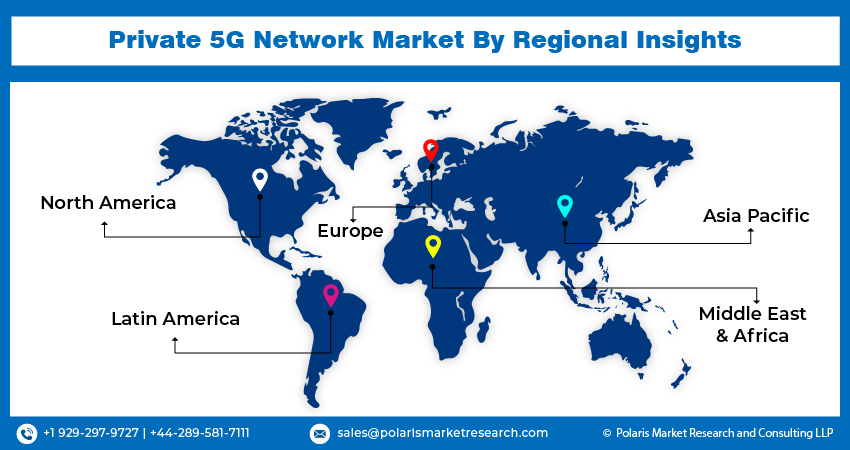
Private 5G Network Market Share, Size, Trends, Industry Analysis Report, By Component (Hardware and Services); By Frequency; By Spectrum; By Vertical; By Region; Segment Forecast, 2024 - 2032
- Published Date:Jan-2024
- Pages: 115
- Format: PDF
- Report ID: PM1718
- Base Year: 2023
- Historical Data: 2019-2022
Report Outlook
The global private 5G network market was valued at USD 938.56 million in 2023 and is expected to grow at a CAGR of 48.1% during the forecast period. A private or non-public 5G network is a dedicated local area network (LAN) that offers enhanced internet connectivity for industrial, enterprise, and other customers. These networks cater to the increasing demand for reliable wireless communication in industrial operations, public safety, and critical infrastructure connectivity. The market's growth is driven by the need for low-latency connectivity for Industrial Internet of Things (IIoT) applications, including industrial sensors, cameras, and collaborative robots.

To Understand More About this Research: Request a Free Sample Report
With the rise of Industry 4.0, major industrial players like ABB Ltd., Mercedes-Benz AG, and Siemens AG have adopted sensor-based technologies and industrial robotics for improved operational efficiency. Private 5G networks provide secure and seamless internet connectivity for these IIoT devices. The demand for Time-Sensitive Networking (TSN) and real-time-based networking is also growing across industries such as manufacturing, oil and gas, aerospace, and transportation, fueling the need for private 5G networks to ensure high-speed and reliable connectivity.
Private 5G networks offer end-to-end security, making them essential for safeguarding information and infrastructure. They are expected to experience high demand in government, public safety, and enterprise data storage applications. The digitalization efforts in the oil and gas industry have further increased the requirement for secure and reliable bandwidth capacity, particularly in the Organization of the Petroleum Exporting Countries (OPEC).
However, the Covid-19 pandemic has impacted the enhanced private 5G infrastructure implementation. The trial, testing, and spectrum auctions disruptions have delayed the market's growth. Governments worldwide, including the US, France, Spain, and Australia, have temporarily postponed 5G spectrum auctions, affecting the industry. Additionally, the decline in exports of telecom instruments for 5G radios and end-user devices due to the pandemic is expected to hinder the market's growth in the foreseeable future.
The Private 5G Network Market report details key market dynamics to help industry players align their business strategies with current and future trends. It examines technological advances and breakthroughs in the industry and their impact on the market presence. Furthermore, a detailed regional analysis of the industry at the local, national, and global levels has been provided.

Industry Dynamics
Growth Drivers
The private 5G network market is experiencing a growing implementation of highly secure 5G network infrastructure in various enterprise and industrial use cases. This trend is driven by the increasing demand for reliable and robust connectivity solutions that meet industries’ specific requirements, such as manufacturing, logistics, healthcare, and smart cities.
Private 5G networks offer enhanced security, low latency, high bandwidth, and network slicing capabilities, making them well-suited for organizations that require dedicated wireless connectivity to support critical operations and sensitive data transmission. Industries with stringent security needs, including defense, finance, and healthcare, are particularly adopting private 5G networks due to their end-to-end encryption, secure authentication, and isolation from public networks.
These networks enable advanced technologies such as the Industrial Internet of Things (IIoT), machine learning, augmented reality (AR), and edge computing, facilitating real-time data analysis and decision-making. With improved coverage, reliability, and quality of service, private 5G networks help organizations enhance operational efficiency, automate processes, and drive innovation.
The rising implementation of highly secure 5G network infrastructure across the enterprise and industrial sectors is expected to continue as organizations recognize the transformative potential of private 5G networks and invest in their deployment to achieve digital transformation and gain a competitive edge.
Report Segmentation
The market is primarily segmented based on component, frequency, spectrum, vertical and region.
|
By Component |
By Frequency |
By Spectrum |
By Vertical |
By Region |
|
|
|
|
|
To Understand the Scope of this Report: Speak to Analyst
The Hardware Segment Holds the Largest Share of the Revenue in 2022
The hardware segment holds the largest revenue share in the market. This is primarily due to the widespread deployment of core networks and backhaul and transport equipment globally. The Radio Access Network (RAN), core network, and backhaul and transport sub-segments play crucial roles within the hardware segment. Key network providers like Nokia Corporation, Qualcomm Technologies, Inc., and Ericsson are deploying advanced equipment to support efficient operations and deliver high-speed bandwidth, thereby driving the growth of this segment.
Meanwhile, the services segment encompasses installation & integration, data services, and support & maintenance. With a growing emphasis on installing private 5G core networks for dedicated users to manage their data securely, the installation and integration services sub-segment is expected to experience substantial growth from 2023 to 2030. This reflects the increasing demand for professional services that facilitate the seamless integration and functioning of private 5G networks.
The Sub-6 Ghz Segment Held the Largest Revenue Share in 2022
The sub-6 GHz segment holds the largest private 5G network revenue share. This segment is projected to witness a substantial CAGR over the forecast period. Sub-6 GHz frequencies include low band and mid-band spectrum ranges, primarily 6 GHz and below.
Governments in key countries like China, the U.S., Japan, and South Korea have recently allocated sub-6 GHz frequencies for 5G services. On the other hand, mmWave frequencies represent high band frequencies that offer exceptionally high connectivity with minimal latency. These frequencies are particularly useful in scenarios that require ultra-reliable connectivity, especially in infrastructure applications.

The Unlicensed/Shared Spectrum Segment Dominated the Market in 2022 and Will Continue Its Dominance Over the Projected Period
This growth is driven by the increasing demand for affordable high-speed private 5G networks. The unlicensed spectrum provides easily accessible bandwidth, making it highly preferred for massive machine-type communications applications.
In contrast, the licensed spectrum requires companies to purchase an entire license for a specific spectrum bandwidth to ensure enhanced and secure internet connectivity. While it is relatively more expensive than the unlicensed/shared spectrum, it offers greater reliability. The licensed spectrum can be obtained through Communication Service Providers (CSP). Some countries like the U.S. and Germany utilize the licensed spectrum for industrial and mission-critical applications. The licensed spectrum segment is expected to be driven by the increasing demand for highly secure connectivity in mission-critical applications such as Automated Guided Vehicles (AGV) over the forecast period.
North America Dominated the Global Market in 2022
North America dominates the market with a market share. This is attributed to the presence of key solution providers like Qualcomm Technologies, Inc., and significant investments by leading service providers such as AT&T Inc. and Verizon Communications in deploying private 5G network infrastructure. The region also benefits from the robust deployment of industrial sensors by major automakers like Ford Motor Company and General Motors Company, creating growth opportunities. The increasing demand for Ultra-reliable Bandwidth Low Latency Connectivity (URLLC) across verticals like public safety, oil and gas, and aerospace and defense further drives the market growth in North America.
Asia Pacific is expected to be the fastest-growing regional market over the projected period. The region benefits from the presence of manufacturers and their investments in automated factories. Key countries in the region, including China, Japan, South Korea, and Australia, are making significant investments to acquire 5G spectrum, contributing to market growth. Private 5G services are anticipated to become more popular in the area due to industrial companies like ABB Ltd., Siemens AG, and Mercedes Benz shifting to developing autonomous industries in Europe, notably in Germany and the U.K.

Competitive Insight
Some of the major players operating in the global private 5G network market include Qualcomm Technologies, Inc., Ericsson, Huawei Technologies Co., Vodafone Limited, Ericsson, Deutsche Telekom, Nokia Corporation, T-Systems International GmbH, Verizon Communications, AT&T Inc., Broadcom Inc., Ltd, Altiostar, SAMSUNG, Cisco Systems, Inc., ZTE Corporation, and others.
Recent Developments
- In February 2022, Qualcomm Technologies collaborated with Microsoft to provide chip-to-cloud solutions, enabling the efficient deployment of private 5G networks worldwide.
- In February 2020, Vodafone partnered with Lufthansa Technik to create a private 5G network at Hamburg Airport. The collaboration allows Lufthansa Technik to tailor the network setup to their requirements.
Private 5G Network Market Report Scope
|
Report Attributes |
Details |
|
Market size value in 2024 |
USD 1363.69 million |
|
Revenue forecast in 2032 |
USD 103,516.54 million |
|
CAGR |
48.1% from 2024 – 2032 |
|
Base year |
2023 |
|
Historical data |
2019 – 2022 |
|
Forecast period |
2024 – 2032 |
|
Quantitative units |
Revenue in USD million and CAGR from 2024 to 2032 |
|
Segments Covered |
By Component, By Frequency, By Spectrum, By Vertical, By Region |
|
Regional scope |
North America, Europe, Asia Pacific, Latin America, Middle East & Africa |
|
Key Companies |
Qualcomm Technologies, Inc., Ericsson, Huawei Technologies Co., Vodafone Limited, Ericsson, Deutsche Telekom, Nokia Corporation, T-Systems International GmbH, Verizon Communications, AT&T Inc., Broadcom Inc., Ltd, Altiostar, SAMSUNG, Cisco Systems, Inc., ZTE Corporation |
Gain profound insights into the 2024 Private 5G Network Market with meticulously compiled statistics on market share, size, and revenue growth rate by Polaris Market Research Industry Reports. This thorough analysis not only provides a glimpse into historical trends but also unfolds a roadmap with a market forecast extending to 2032. Immerse yourself in the comprehensive nature of this industry analysis through a complimentary PDF download of the sample report.
Browse Our Top Selling Reports
Point of Entry Water Treatment System Market Size, Share 2024 Research Report
Electric Vehicle (EV) Charging Infrastructure Market Size, Share 2024 Research Report
Clinical Trial Supplies Market Size, Share 2024 Research Report
FAQ's
The private 5G network market report covering key segments are component, frequency, spectrum, vertical and region.
Private 5G Network Market Size Worth $103,516.54 Million By 2032.
The global private 5G network market expected to grow at a CAGR of 48.1% during the forecast period.
North America is leading the global market.
key driving factors in private 5G network market are increasing adoption of private networks.
